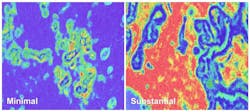National Institutes of Health (NIH) scientists have uncovered a possible breast cancer biomarker that could help distinguish high risk patients and lead to better prevention and treatment.
The biomarker, stromal disruption, is “a series of changes in the architecture and cell composition of connective tissues of the breast,” and “is associated with an increased risk of developing aggressive breast cancer among women with benign breast disease, and poorer rates of survival among women with invasive breast cancer.” An NIH announcement emphasizes that stromal disruption is reasonably priced and could be an accessible strategy.
The researchers used artificial intelligence (AI) for their analysis. Details of the study can be found on NIH’s website.

